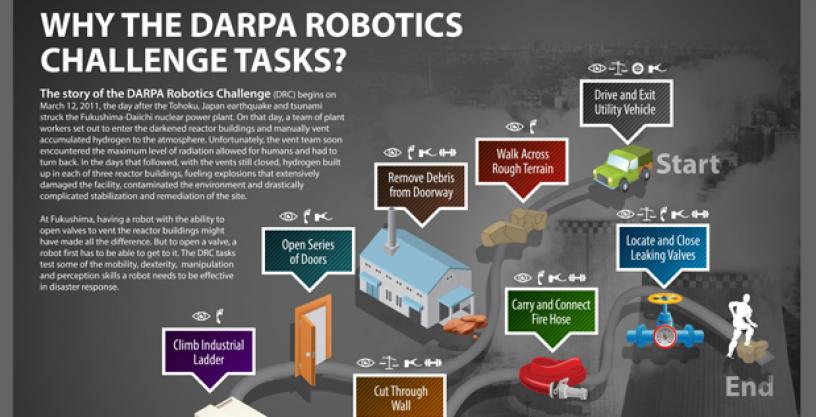
Teams from around the world demonstrate diverse approaches and expertise while collaborating toward a common goal: improving robotics for disaster response
Dec 19, 2013
They walk, crawl and roll. They take inspiration from humans and animals, and come in sizes tall and small, skinny and wide. They represent five countries around the world. They are the robots of the DARPA Robotics Challenge (DRC) Trials, and they and their human operators have all been practicing very, very hard.
The teams scheduled to compete in the DRC Trials—taking place December 20-21 at the Homestead-Miami Speedway in Homestead, Fla.—are a mix of government, academic and commercial organizations from around the globe. They vary from each other in many ways, such as team size and experience, focus on hardware and/or software, and the design and capabilities of their entries. What all teams share, however, is commitment to a common goal: to speed development of robots that could aid in response efforts after future natural and man-made disasters.
“We're thrilled to have such an accomplished and diverse group participate,” said Gill Pratt, DARPA program manager. “We’re eager to see how teams pushed the design envelope, especially because they all had less than a year to get ready—years less than a typical robotics program. How their choices play out on the testing course this weekend could determine not just what we see at the DRC Finals next year, but in disaster-response robotics for years to come.”
Early in the program, the DRC divided the teams into four tracks based on whether a team would develop complete systems combining robotics hardware and software or robotics software only, and whether a team would receive DARPA funding:
- Track A: Selected through proposal review to receive DARPA funding to develop hardware and software systems (view Track A teams here)
- Track B: Selected through proposal review to receive DARPA funding to develop software; competed in the June 2013 Virtual Robotics Challenge to use a government-furnished Atlas robot in the DRC Trials (view Track B teams here)
- Track C: Initially not funded by DARPA, teams developed only software with no DARPA funding; competed in the June 2013 Virtual Robotics Challenge to receive DARPA funding and use a government-furnished Atlas robot for use in the DRC Trials (view Track C teams here)
- Track D: Teams that developed hardware and software systems with no DARPA funding (view Track D teams here)
The teams in Tracks A, B and C are vying for up to eight DARPA-funded slots in the 2014 DRC Finals. Because they operate with independent funding, the Track D teams can automatically advance to the DRC Finals if they so choose.
The DRC Trials are free and open to the public and media. In addition to the competition, the onsite DRC Exposition will showcase technology related to disaster response, robotics and autonomy. It will include, among others, demonstrations of DARPA’s “Wild Cat” (an untethered, all-terrain version of the “Cheetah” robot) and Legged Squad Support System (LS3).
|
|
|
|
|
|
|
|
|
Tracks B/C Teams
All Track B and C teams are using the same model of ATLAS robot.
|
|
|
|
|
|
|
|
|
|
|
|
|
|
|
|
|
|
# # #
Associated images posted on www.darpa.mil and video posted at www.youtube.com/darpatv may be reused according to the terms of the DARPA User Agreement, available here: http://www.darpa.mil/policy/usage-policy.
Tweet @darpa


















